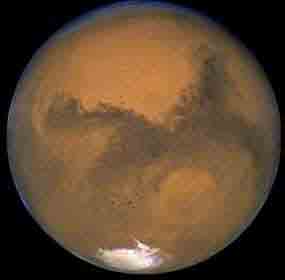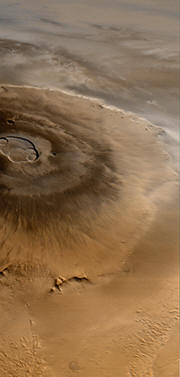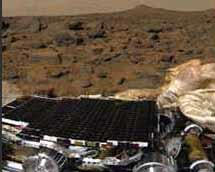|
         
> The Sun
> Mercury
> Venus
> Earth
> Mars
> Jupiter
> Saturn
> Uranus
> Neptune
> Pluto
> The 10th Planet?
> Asteroids
> Comets
> The 'Edge'
  
|
Mars is about half the
size of our planet, Earth. It's thin atmosphere is slowly being blown away
by the sun's solar wind. However, its atmosphere forms clouds, and
sometimes supports planet-wide dust storms.

The red planet has many features that are visible to the backyard observer
with a powerful enough telescope. First of all, Mars has a reddish color
due to the iron oxide - commonly known as rust - that is in the soil.
The first feature that most can see on Mars are the polar ice caps. These
huge caps of water and carbon dioxide ice expand and shrink due to
seasonal changes on Mars.
Second, "canals" and "seas" cover the entire planet. The canals may have
been waterways many millions or billions of years ago, but they are now
dry, as are the seas. The seas were probably oceans that covered parts of
Mars.
Third, the largest volcano in our solar system, Olympus Mons, lies on
Mars. It is 24 km (15 miles) high, and the top of it is 70 km (40 miles)
wide; the base is about 600 km (375 miles) wide. This volcano is now
dormant, but was active millions of years ago.
Mars is also home to one of the longest (more than 4,000 km (2500 miles
long)) canyon systems in the solar system called Valles Marineris
("Mariner Valley"). The canyon system ranges from 5 to 8 km (3-5 miles)
deep. If placed on Earth, this would stretch from New York to Los Angeles.
Explorations
The USSR in May 1971 launched Mars 2 and 3, two probes
that crash-landed on Mars but transmitted data briefly. In August 1973, it launched Mars 4, 5, 6, and 7,
but various technical malfunctions plagued all these missions. In 1988 the
USSR sent two probes, Phobos 1 and 2, to land on the Martian moon Phobos;
the first was lost through human error, and the second dropped out of
radio contact.
transmitted data briefly. In August 1973, it launched Mars 4, 5, 6, and 7,
but various technical malfunctions plagued all these missions. In 1988 the
USSR sent two probes, Phobos 1 and 2, to land on the Martian moon Phobos;
the first was lost through human error, and the second dropped out of
radio contact. In the US programme, Mariner 4, launched in
November 1964, flew past Mars in July 1965 and transmitted to Earth the
first close-up photographs of the Martian surface, which revealed the
presence of craters. It was followed, in 1969, by Mariners 6 and 7, which
also flew past the planet and added to the previous data. Then, in May
1971, Mariner 9 was launched. It orbited Mars from November 1971 to
October 1972, and transmitted enough photographs for an almost complete
map of the planet. In August and September 1975, Vikings 1 and 2 began an
11-month journey to Mars. Each spacecraft carried a lander equipped with
life-detecting and chemical laboratories, two colour television cameras,
weather and seismographic instruments, and a 3-m (10-ft) retractable claw
designed to be manipulated from the Earth. Both functioned well for
several years. After the loss of the Mars Observer spacecraft in 1995, US
exploration of Mars resumed in 1997 when two spacecraft, the Mars Global
Surveyor orbiter and the Mars Pathfinder lander, reached the planet and
began successful missions. Pathfinder included a small rover, named
Sojourner, which investigated the area around the lander
largely under autonomous control. Mars Global Surveyor has been mapping
the planet since April 1999, producing a detailed picture of its
topography. However, two subsequent missions, the Mars Climate Orbiter and
Mars Polar Lander, were lost in 1999, both suddenly ceasing communication
as they reached the planet. In April 2001 another probe, Mars Odyssey, was
launched. It successfully entered into orbit around Mars in October 2001.
 |
Sojourner Microrover
The Mars Pathfinder spacecraft landed on the
planet Mars in July 1997. Pathfinder carried a small roving vehicle,
called Sojourner, that moved about the surface of Mars near the
lander, measuring the chemical composition of Martian rocks.
Sojourner is shown here still on-board the lander in a photograph
taken by the Pathfinder cameras. The white material behind the rover
is what remained of the airbags that cushioned the lander’s fall.
The two hills in the background (dubbed the “twin peaks”) are almost
1.6 km (1 mi) away. |
[Top] Unique
Characteristics
Mars is the most Earth-like planet in the solar system
(except for in size and therefore surface gravity; Venus takes the cake
for that characteristic). Because of this, several scientists believe
that, if done correctly, Mars can be terra formed into a planet
inhabitable by humans.
Mars has some unique characteristics. First off, Mars has the largest
volcano in the solar system, Olympus Mons. It also has the largest canyon
system in the solar system called Valles Marineris. Third, Mars is the
only other planet besides Earth to posses frozen water at its poles, which
scientists have seen grow and shrink as the Mars seasons change. Fourth,
Mars is the only other planet (that we know of) that has the capability of
supporting life, past or present. Mars' Satellite
When most people think of a moon, they think of the
relatively large whitish globe that they see at night, and sometimes
during the day. While this is a moon, it is not typical of moons in the
solar system. In fact, Earth has the largest moon in the solar system,
relative to the planet's size, if you don't include Pluto. Most other
moons are much smaller.
Mars' moons are no exception. With Phobos measuring 13.4x9.2 km (8.3x5.7
miles) and Deimos at 7.5x5.2 km (4.7x3.2 miles), they are runts compared
to Mars' size. Spacecraft sent to Mars have photographed the moons. Phobos
has craters of all sized on it; it also has long grooves radiating from
its largest crater. Deimos has a few small craters. Its surface is covered
by a fine dust, but it also has boulders on it - some as large as a house.
[Top]
Discovery
Unlike the planet itself, Mars' moons have not been known
since antiquity. Rather, they were discovered in 1877 by a keen-eyed U.S.
astronomer in Washington, D.C. In a hazy August evening, Professor of
Mathematics in the U.S. Navy Corps of Mathematics, Asaph Hall, was
studying Mars with the 26 inch "Great Equatorial" telescope at the U.S.
Naval Observatory with his assistant, George Anderson.
Prof. Hall was sweeping the telescope around the edge of Mars when he saw
what looked like a star - except that he had seen it five nights earlier
along with the planet. He noted that it appeared to be moving with Mars as
opposed to staying fixed relative the the stellar background. Later that
night, he saw a brighter "star" that was even closer to the planet's disk.
On August 18, several astronomers came to the telescope with Hall and
observed the "stars," recording their positions in the telescope's log
book. Mars' two moons, Deimos and Phobos, had been discovered.
[Top]
Origin
Mars' moons are probably not native to Mars. Most likely,
they are asteroids that were captured by Mars' gravity, and could not
escape. Besides their small size hinting at this, the fact that their
orbits have high eccentricity - they deviate from a perfect circle - than
most moons suggests that they did not originate around the planet.
[Top] External Links
[Back] [Top] [Next] |

 transmitted data briefly. In August 1973, it launched Mars 4, 5, 6, and 7,
but various technical malfunctions plagued all these missions. In 1988 the
USSR sent two probes, Phobos 1 and 2, to land on the Martian moon Phobos;
the first was lost through human error, and the second dropped out of
radio contact.
transmitted data briefly. In August 1973, it launched Mars 4, 5, 6, and 7,
but various technical malfunctions plagued all these missions. In 1988 the
USSR sent two probes, Phobos 1 and 2, to land on the Martian moon Phobos;
the first was lost through human error, and the second dropped out of
radio contact.